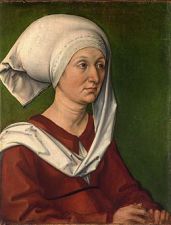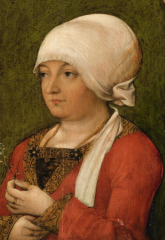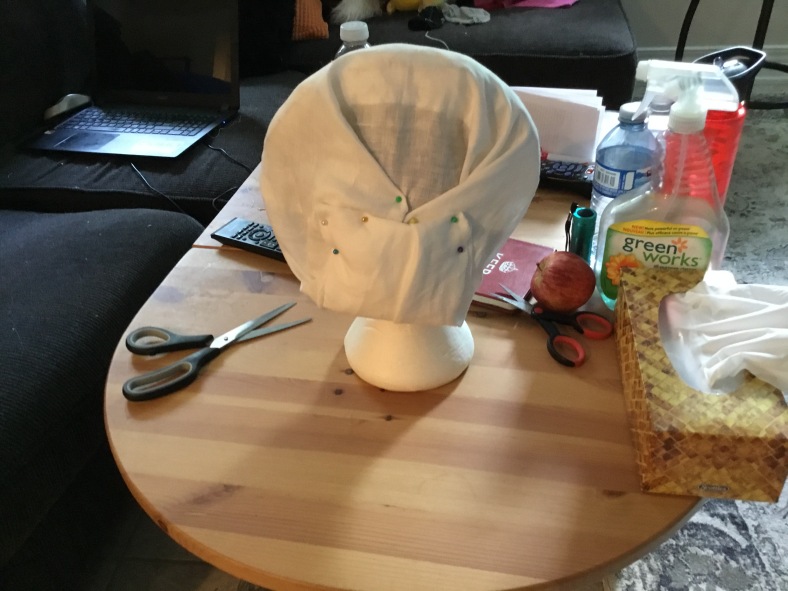Source: Based on Albrecht Durer’s painting of his Mother Barbara Durer in 1490.
Goal
Create a 15th century head covering based on the painting of Albrecht Durer mother Barbara made in 1490.
Approach
I have looked at various examples but am basing this project on the head covering in the Barbara Durer painting. I have not found any surviving examples so most of the construction is done by looking at examples. There are many examples in paintings.
The one in Barbara Durer’s painting was modest. She was painted by her son, and was considered pious so it makes sense she was not in gold flecked covering.
I did not find any surviving examples, but there are many images. So, I have looked to those who have already made one online and tried to see what would work for me.
 |
 |
 |
| Portrait of Barbara Durer (1490) | Hans Schüchlin(?), Double portrait of a man and his wife, 1479. Tempera
|
Swabian School, circa 1515 Portrait of a Patrician Lady
|
In the source painting, the bulge is organic, rather than rigid form that came later, and it is larger that what I think her real hair would provide. The tail is rather long and the length of the steuchlin indicated the wealth of the wearer. I decided to go with a loose wulst with out a rigid support.
I wanted to make a wulsthaube and steuchlin that has the height and organic quality of the one in the painting, but could also be repurposed to use a more rigid wulst later on.
Sources
I picked the portions of the process I liked the most from the following blogs and incorporated them into my project. I am a very visual learner and find this much easier to start with and adapt. btw, I love these and the garb that is produced.
Katafalk
https://katafalk.wordpress.com/2013/01/01/patternmaking-for-the-kampfrau-wulsthaube/
Handcrafted History
https://handcraftedhistory.blog/2018/12/04/15th-century-headwear/
In Nova Corpora
http://www.in-nova-corpora.ch/naehstube/ma_15_unterkleidung_text.htm
Terms
Wulsthaube – the cap that directly sits on the head that contains a roll of fabric or could be reeds to create a rounder shape
Wulste – The roll of fabric that is used to give height to the overall look of the head covering. It could be included in the Wulstaube, or separate.
Steuchlein – a long rectangular veil that covers the wulst or wulsthaube.
Process
Wulsthaube and Wulst
- In cotton, I took a square of fabric that was able to wrap around my forehead to the nape of my neck.
- I made a wulst by creating a crescent shaped tube and stuffed with some cotton banting. Just to get started.
- I placed the wulst on my head to check on placement, and draped the rectangle over top of that. Then pinned it to the wulst. At this point I saw the square needed to be more of a rectangle and thought it would work better if it was tapered from front to back.
Then I moved on to a version in linen.
- I made a new wulst in linen, a little longer and stuffed with fabric pieces.
- I cut a rectangle and hemmed all the edges. After that was done, I again placed it on my head and pinned the fabric roll to it. In Nova Corpora she has placed a rectangle piece of fabric over the roll to help hold it in place. The added benefit is that it smooths out the shape of the roll. As an added bonus, it works as holder that can be used to swap out other wulst if I choose another look.
-

Wulst pinned to underside of wulstaube. The rectangle fabric above the wulst is sewn to the wulstaube to smooth out the shape
I placed this on a styroform head form and proceeded to pin the fabric on the back of the wulstaube. This is based on Katafalk’s method of constructing her Wulstaube.
- Sewed the folds in the back down
- The crescent shape of the wulst was poking out pinned and sewed the edges of the wulst section so the crescent shape

Streichlein
Version 1
This was very much a trial and error process for me.

- The Streichlein in the painting is similar to a great veil that I found in Handcrafted Histories blog. I used her method of creating the veil as the length matched what I thought was needed to match the painting.
- The front of the streichlein has many folds (vachern) that frame the face. I started with a piece of fabric that was roughly 60 by 120 inches. On the short edge that is near the face, I created 7 folds and sewed each down, then hemmed around the edge.
I put the veil on the head form, with the folds in the front then pinned the edges to the wulst near the back of the head, then wrapped veil up and over the head.
It wasn’t working for me, the movement of the veil when it curved up had a very different look than the painting.
I went back to the original painting again and decided to wrap it differently by putting the short edge on the left side of the face, pinning it in place then wrapping it around the head 1 and a half times. It was a little more bunched up and created more of a bulge. Then I smoothed out the width of it and let it hang flat over the side of the head again and down. It matched the look of the wrap in the painting.
Some observations at this point.
- I am not positive, but think that if the length of the veil was long enough, the wrapping around the head would create the bulge shape, without a wulst. But may not be big enough to be consistent with the painting.
- If using a wulst, the wulst would need to be larger than what I had and less rigid than the one I constructed.
Version 2
I put it aside for a bit and worked on the dress then came back to. After changes this is what I came up with and like it.

This has elements from both Nova Corpora’s post as well as Handcrafted History, as well as some testing on my own.
- I removed the folds on the left side of the first veil
- I made a new set of folds the width of the veil and attached to the long side. To determine the location, I put the veil back on the head form, wrapped it the way I wanted to and pinned the folds to the fabric where it would frame my face.
- Added ties to the folded section to tie beneath my head.
Wulst or no Wulste?
I still get pulled back to the painting. I was torn between keeping the wulsthaube under the steuchlin for height,but if I wrapped the streichlin around my head enough times ( and was log enough) it would also give a similar effect. My steuchlin is not long enough to make the bulge required to match the size on the painting, and I definitely don’t have enough hair.
Most of what I have read says that they used a wulsthaube underneath but I could see the one in the painting being done without if she had enough hair. It is possible it is creative license by the artist.
I decided to keep using, the wulsthaube because it adds height that my hair does not have. I plan on using this later.
Conclusions
I am happy with the result. I am able to get some height added to the wulsthaube by wrapping the fabric around my head. And by having the folds in front it gives a very similar look to the painting. Having the wulst sewn into a pocket on the wulsthaube allows me to change the height if wanted. The front of the steuchlin being on the long side gave the correct wrapping a similar look to the painting.
When I make another one I will create a folded section down the entire length of one side of the steuchlin for aesthetics. I didn’t feel it was necessary for this.





